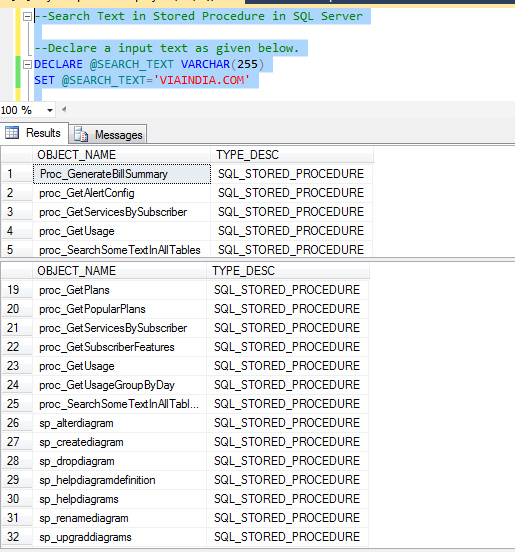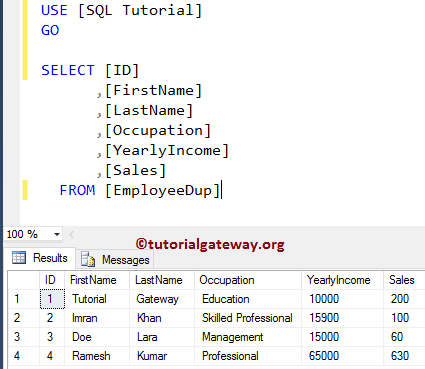
#DB2 DBVISUALIZER CREATE STORED PROCEDURE SERIES#
Now let's start with a series of practical examples of generating Execution plans for various scenarios.Ĭreating a table CREATE TABLE DEPOSITS (ID INTEGER GENERATED ALWAYS AS IDENTITY,ĬONSTRAINT CK_INCASH CHECK (INCASH IN ('Y','N'))) SQL command development tools such as DBVisualizer or DBeaver have different methods of viewing Execution Plans. One of the most important information contained in an Execution Plan, which is how columns are used in indexes and tables, is shown in DBeaver when going through the plan's nodes in its visualization tool. In DBVisualizer, this information is not yet available visually (the supplier has already been asked to implement this functionality), and we have to perform the above procedure to obtain this information.Practical examples of SQLs in tables, with various indexing scenarios and execution plans Practical examples of SQLs in tables, with various indexing scenarios and execution plans execute the command listed below in the "SQL to analyze the Execution Plan".
 execute the command: EXPLAIN PLAN FOR. accessing the menu option "SQL Commander -> Execute Explain Plan"īut in order for us to see the details of the execution plan we will have to proceed as follows:. In the DBVisualizer tool, we generate the Execution Plan in two ways: The EXPLAIN Command and Development Tools The IBM DB2 EXPLAIN Command generates the Execution Plan for an SQL command, and stores that plan in IBM DB2 tables. These tables are usually created in the "SYSTOOLS" schema . We will see that it is essential that the generation of the plan is followed by a detailed analysis, explained in the section "Making an even better and mandatory analysis of the Execution Plan" . analyze Execution Plans and execution statistics for SQL commands. keep the statistics of tables and indexes up to date. create the masses of data with volume and variety.
execute the command: EXPLAIN PLAN FOR. accessing the menu option "SQL Commander -> Execute Explain Plan"īut in order for us to see the details of the execution plan we will have to proceed as follows:. In the DBVisualizer tool, we generate the Execution Plan in two ways: The EXPLAIN Command and Development Tools The IBM DB2 EXPLAIN Command generates the Execution Plan for an SQL command, and stores that plan in IBM DB2 tables. These tables are usually created in the "SYSTOOLS" schema . We will see that it is essential that the generation of the plan is followed by a detailed analysis, explained in the section "Making an even better and mandatory analysis of the Execution Plan" . analyze Execution Plans and execution statistics for SQL commands. keep the statistics of tables and indexes up to date. create the masses of data with volume and variety. 
Remember that it is the responsibility of the analysts, developers and homologators of the test environments: Test environments that do not have volume or variety proportional to production environments are not suitable for performance tests, since the Execution Plans and the execution statistics (average number of blocks / records read) will be very different from those of the production environments.
the table and index statistics Data must be kept up to date. the records must be created with the characteristics of variety and cardinality that the attributes of the table will have in production. As a general rule of thumb, consider that any table that will have thousands / millions of records in production should have at least 30,000 records in the test environments. populate tables with a significant volume of records. Indexes created emergency in production, for example, should be created in test environments as soon as possible. The only acceptable difference between environments is that when changes are being made to the test environments. create and maintain tables and indexes with structures similar to those of production. In order for us to detect performance problems in SQL commands as early as possible, it is essential that test environments have similar characteristics and proportional to production environments. the generation and analysis of the SQL Execution Plans. constant maintenance of data statistics. the use of good practices in writing SQL commands. a good structure of the tables and their indexes. There are several factors that contribute to ensuring the good performance of an SQL command: the physical characteristics of the database server: memory, processors, number of storage devices and server. statistics about the data: number of records, column cardinality, etc. the physical structure of the table: type of table (normal, range partitioned, MDC - Multidimensional clustering tables, etc). The plans are generated taking into account a number of factors: 
Execution plans are generated for several SQL commands, including SELECT, UPDATE, DELETE and INSERT commands.

He is the "brain" responsible for generating the Execution Plans, which are the strategies for accessing the data contained in the tables. IBM - Query Plans and Explain One of the main components of a Database Management System (DBMS) is the optimizer.








 0 kommentar(er)
0 kommentar(er)
